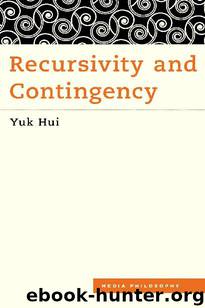Recursivity and Contingency (Media Philosophy) by Yuk Hui

Author:Yuk Hui [Hui, Yuk]
Language: eng
Format: epub
Publisher: Rowman & Littlefield International
Published: 2019-01-27T16:00:00+00:00
It is in Descartes that the distinction between nature and technics is blurred, not because Descartes wanted to reconcile nature and technics as two opposing realities, as we see them today, but rather because for him they share a common principle: namely, mechanism. This is also the reason why we may say that, having mechanism as the common ground, technics is elevated to be the primacy of knowledge. In other words, technics is not a mere application of scientific knowledge; rather, it is thanks to technics and technical activities that science is made to appear on the occasion of technical breakdown. Descartes, a philosopher who reflected often on both the art of making and of medicine, sees a discrepancy between practice and theory in terms of which they are not reducible to one another, but rather together constitute a cycle of knowledge production. In another article titled “Activité technique et creation,” which was originally a talk given in 1938 at the Société Toulousaine de philosophie, Canguilhem writes: “The fact is that the modern world simultaneously presents a multiplication of theories and a multiplication of techniques. But we cannot say if it is the technical boom that depends on the scientific boom or the other way around.”22
However, this apparent undecidability is only a strategy for affirming the primacy of technics and of creation, which is more primary than scientific knowledge as representation.23 Canguilhem gives various examples—thermodynamics, Pasteur’s theory, the laws of electrostatics—that emerged out of practical obstacles in relation to the steam engine, alcohol manufacturing, improving the compass, and so on, and he doesn’t forget to mention that the laws of dioptrics were formulated in relation to the problem of the size of the glass described by Descartes in his Dioptrique. He therefore arrives at the conclusion that “the rise of scientific thought is conditioned by the failure of technical thought.”24 Canguilhem rejects the idea that technology is an application of scientific knowledge; rather, he sees science and technology as two regimes of knowledge that inform each other. Retrospectively, we should be able to notice that with the advancement of technology, the dynamic of such circularity is largely altered (see chapter 5).
Mechanism, understood as a principle of nature, allows Descartes to reverse the intuitive relation between science and technology, which remains an important source of inspiration for Canguilhem. However, the major problem of conceiving life in terms of mechanism is that it attempts to “completely explain life without life.”25 In “Machine and Organism,” Canguilhem wants to question the Cartesian conception of the relation between organism and machine and to show that such a reduction should be reversed by recognizing the preexistence of the organism, meaning that biology is prior to technics. And if biology or organism is prior to technics, then this difference, and the dynamics between the two, should be rethought. The central question is not whether mechanism can produce the organism or if mechanism is equivalent to an organism, but rather the relation between the organic and the inorganic (here we can talk about technical objects) has to be systematically articulated.
Download
This site does not store any files on its server. We only index and link to content provided by other sites. Please contact the content providers to delete copyright contents if any and email us, we'll remove relevant links or contents immediately.
| Computer Vision & Pattern Recognition | Expert Systems |
| Intelligence & Semantics | Machine Theory |
| Natural Language Processing | Neural Networks |
Algorithms of the Intelligent Web by Haralambos Marmanis;Dmitry Babenko(16235)
Jquery UI in Action : Master the concepts Of Jquery UI: A Step By Step Approach by ANMOL GOYAL(9387)
Test-Driven Development with Java by Alan Mellor(7735)
Data Augmentation with Python by Duc Haba(7609)
Principles of Data Fabric by Sonia Mezzetta(7378)
Learn Blender Simulations the Right Way by Stephen Pearson(7294)
Microservices with Spring Boot 3 and Spring Cloud by Magnus Larsson(7137)
Hadoop in Practice by Alex Holmes(6588)
RPA Solution Architect's Handbook by Sachin Sahgal(6517)
The Infinite Retina by Robert Scoble Irena Cronin(6216)
Big Data Analysis with Python by Ivan Marin(5934)
Life 3.0: Being Human in the Age of Artificial Intelligence by Tegmark Max(5516)
Pretrain Vision and Large Language Models in Python by Emily Webber(4894)
Infrastructure as Code for Beginners by Russ McKendrick(4653)
Functional Programming in JavaScript by Mantyla Dan(4436)
WordPress Plugin Development Cookbook by Yannick Lefebvre(4382)
The Age of Surveillance Capitalism by Shoshana Zuboff(4248)
Embracing Microservices Design by Ovais Mehboob Ahmed Khan Nabil Siddiqui and Timothy Oleson(4148)
Applied Machine Learning for Healthcare and Life Sciences Using AWS by Ujjwal Ratan(4135)
